Who Invented Laptop
Adam Osborne invented the laptop in 1981. Though Osborne 1 was recognized as the first laptop, the concept of a portable computer was given in 1968 by Alan Kay. Alan Kay's DynabookAlan Kay invented and designed the concept of the portable computer while working for Xerox PARC. This concept then came to be known as Dynabook. Later, it became the basis for the generation of laptops, tablets, and e-books. Kay envisioned revolutionizing the education system by bringing forth Dynabook as an educational platform and research on mobile learning. While designing the idea of Dynabook, he emphasized connecting educational communities with parents and students. Though Dynabook was never manufactured, it started the journey of portable computers. 
Evolution of LaptopsIBM 5100 In 1975, a portable computer weighingonly 55 pounds was available to the general public.IBM 5100 was much lighter and portable when compared to other previous computers. XEROX Note-Taker Xerox note-taker was designed and developed by the Xerox Corporation team in 1978. It comprised of a folding keyboard that would show the screen after unfolding it. Features of Xerox note-taker include 256 kilobytes of RAM and a 5 MHz Intel CPU. Osborne 1 Osborne 1 is the first laptop computer known. It was the first commercially successful computer costing $1795, which was almost one-half of the price of other computers with similar features.It weighed 25 pounds and comprised of a large bundle of software. 
Epson HX-20 In 1981, Epson launched a tiny battery-powered portable computer. This system is comprised of rechargeable batteries and a 120 * 32 - pixel LCD. The business magazine hailed it as the fourth revolution in personal computing for its innovative features. Grid Compass 1101 Grid Compass 1101 very closely resembled our current laptops. However, it was designed for specialized application and portability, which led to its high cost. Nevertheless, the US government uses it. NASA also used it in the 1980s on the space shuttle because of its extraordinary properties, like a lightweight. Then the special forces used them for their ruggedness and use of solid-state memory. Kaypro 2000 Kaypro 2000 was invented by Andrew Kay in 1985, was the first commercially used laptop with IBM compatibility. It was an 8/16 bit device. It was very much similar to the modern laptops in design. It had a detachable keyboard and a 3.5-inch floppy drive. IBM PC convertible The IBM PC convertiblehad 256 KB of RAM. It is known for introducing a 3.5" floppy disk format for the first time.Later, this became the industry standard. In addition, it could run from batteries similar to the laptops we use today. NEC Ultralite The NEC ultralight is the first known notebook-style portable laptop computer, designed in 1989.It weighed around 2 Kg and was priced from $4000 to around $5000. This device was designed as an effort to make an inexpensive, lightweight computer. Apple PowerBook Apple decided to come back in the field of laptops with its power book line. It did so by launching the Apple power book in October 1991. They immediately became popular in the industry with their dark grey cases and positioning of the pointing device. Netbook A netbook is an underpowered Windows machine with a tiny keyboard which is introduced in 2007. Then the two-in-one touch screen devices were launched in 2013 when Microsoft rolled out Windows 8. Windows 95The year 1995 saw the release of Windows 95, which was a big deal for laptop technology. Windows 95 was able to standardize many elements of laptop design. It could talk to the laptops BIOS more directly to handle functions like power management, eradicating the need for a wide variety of BIOSs and drivers. Another feature that is now common in laptops is built-in Wi-Fi. First appeared in 1999 on the Apple iBook, which was even more well known for its exciting design. Subsequent laptops incrementally added features that we are using today like HD screens, webcams, solid-state drives, and even desktop-grade graphics processing. The smaller and more efficient processors helped laptops become thinner and lighter; some are even two pounds which is less than 125th of the weight of the original IBM 5100. Maybe one day, laptops will be as thin as a piece of paper. Impact on peopleBe it travel to your favorite destination or the most critical tasks to manage multitasking with other indoor activities. Laptops are the most reliable and convenient option whenever needed. Laptops have significantly impacted and changed the way people work and travel. Portability is the property of laptops which has made all computer tasks easier for everyone. Portability brings accessibility along with it. Laptops have made it easier to access documents files, music, and other applications anywhere. Laptops have shaped our lives, making them more convenient and more manageable.
Next TopicWho invented the printing press
|
 For Videos Join Our Youtube Channel: Join Now
For Videos Join Our Youtube Channel: Join Now
Feedback
- Send your Feedback to [email protected]
Help Others, Please Share










